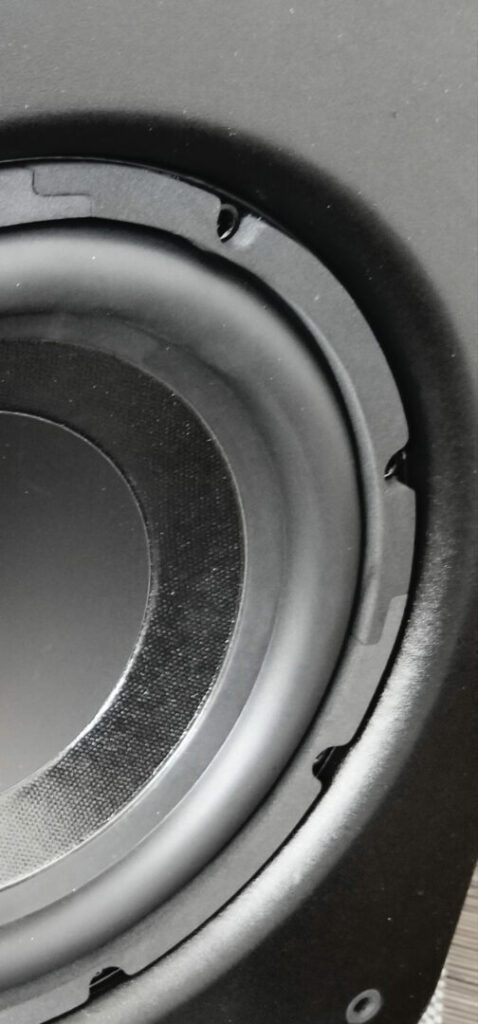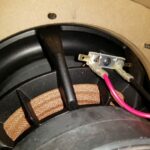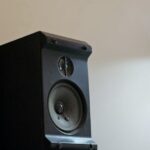10 Inch vs 12 Inch Home Theater Subwoofers (What’s Better?)
10 Inch vs 12 Inch Home Theater Subwoofers (What’s Better?)

When comparing 10 inch vs 12 inch home theater subwoofers, the difference is 10 inch subwoofers tend to work better for smaller apartments & dorms, while 12 inch subs have bigger drivers for more impactful bass. However excursion, internal amplifier power, and continuous wattage are all more important factors. Both sizes of subwoofers have their own strengths and weaknesses.
I personally feel like choosing the right subwoofer for your space can genuinely be the difference between a sub-par movie experience (puns) or one that makes you anticipate the next movie right after.
The sub’s bass adds a lot to the mix, and when actually done right, immerses you in the experience entirely.
But here’s the thing, subwoofers not only come in all shapes and styles, but in sizes too (especially since they can be created DIY)
In fact, some of the best subwoofers for 2025 also happen to be 10 & 12 inch variants.
Which brings us to our question in the title; between 10 inch and 12 inch subwoofers, two of the most common enclosure sizes, which is better?
The answer to that is pretty interesting actually, so we’ll just get right to it.
The Advantages Of 10 Inch Home Theater Subwoofers
They Tend To Be More Accurate With Their Bass
So the first reason why someone might decide to go with a 10 inch sub has to do with the quality of the bass they put out.
Due to the fact they have smaller enclosures and drivers, they don’t have to move nearly as much air as larger subs.
This let’s them be more responsive since they can move air that much faster, and as a result of all of this, tend have a more accurate bass response from what I’ve noticed.
Of course this isn’t across the board since there’s so many other factors that actually goes into the type of bass you experience, (plus there’s always exceptions) but in general it’s what I’ve found to be the case.
They’re Better For Rooms With Limited Size
If you’re limited when it comes to room size but still want to enjoy quality bass, then 10 inch subs can be a good middle ground.
A 10 inch subwoofer can provide a good balance between a deep enough frequency response while still being manageable in size which can be especially helpful for rooms that are limited when it comes to size.
10 Inch Subs Are Easier To Install
Additionally, due to their smaller size, 10 inch subs are often a lot easier to install than larger ones.
Rather than weighing hundreds of pounds and being difficult to move, these smaller variants (while sometimes still heavy) can be installed and moved around without nearly as much effort.
Can Be Stacked Easier
I’ve talked about subwoofer stacking before, but basically stacking your subwoofers one on top of the other can actually benefit your bass quality in a big way.
Without going into too much detail since I’ve already covered it, long story short, stacking them can actually result in a 6 decibel increase in sound.
That can be a noticeable jump in bass output.
The cool thing is that because a 10 inch subwoofer is smaller, it’s easier to actually put them in that configuration as opposed to having to lift a bigger unit.
They May Draw Less Power From The Receiver
Another benefit of a 10 inch subwoofer is they tend to have smaller internal amps which may draw less power from the receiver
This can can a great thing for the more energy conscious.
Better For Quieter Environments
Finally, because of their general lower power capabilities, 10 inch subs are typically better for smaller environments like apartments or dorms where you’d want good bass but without the worry of disturbing others.
The Disadvantages Of 10 Inch Home Theater Subwoofers
The Bass Might Not Be As Deep As Larger Ones
The drawback of 10 inch subwoofers is also their size.
Because they have smaller drivers than a 12 inch versions, the bass that they produce might not be as deep.
However that being said, there are exceptions to that which we’ll get to when we directly compare the 2.
Greater Chance For Them To Distort At Higher Volumes Due To Less Powerful Internal Amps
A problem with some 10 inch subwoofer is that because the internal amps they use aren’t as powerful and the drivers they use aren’t as big, they can distort when played at higher volumes.
This is because the cone has to work a lot harder to push more air, and when pushed past its intended range, the bass it produces can start to sound distorted.
Playing at really high volumes also has a direct impact on how long it lasts since the voice coil (an important part of the subwoofer) can heat up along with the rest of the internals.
The Advantages Of 12 Inch Subwoofers
Have Bigger Drivers For Deeper Bass
So when it comes to a 12 inch subwoofer, there’s definitely a few major benefits over a smaller subwoofer.
The first is much deeper bass!
These larger drivers can often push a higher degree of air, the result of which is an incredibly low bass response.
In fact, some subwoofers in this range can dig below 20 Hz (the audible range of human hearing)
What happens below this frequency range is pretty interesting.
Rather than hearing the bass, you actually start to feel it instead, which can reach into the infrasonic ranges.
If done right, it can actually pressurize the room, which is a different level of immersion entirely
Now if you’ve never experienced that kind of bass, it’s really hard to describe, but it basically makes the sound mix an entirely tactile experience.
This of course requires a lot of power, which leads into the next point..
Larger Enclosures Allows Them To Push More Air
Since the driver and enclosure are larger in a 12 inch sub, it can push more air overall due to the increase in power.
Remember, the more air a subwoofer driver can move efficiently (of course without distorting too while doing so) the lower the bass you experience.
While not the end all, the peak wattage and RMS (which is the continuous amount of power it uses in normal circumstances) is a good metric for this.
That combined with a likely more powerful internal amp, which can be one of several classes makes it a great choice for really large rooms (or even smaller rooms too if you make the space for it)
Of course how low the bass goes is still going to also depend on that device in particular, but in general, these are still a good rules of thumb to guage initial performance.
Less Chance To Distort At Higher Volumes
Also, because 12 inch subwoofers can play at higher volumes, likely being constructed of better materials to accommodate this, there’s less chance for them to distort at higher volumes (though it depends too)
Distortion can easily ruin bass quality and the chances of noticing it becomes higher the louder the volume is.
Luckily these larger subwoofers are often able to handle louder volumes more easily.
Disadvantages Of 12 Inch Subwoofers
Can Be Less Accurate In Bass Response
So the one drawback that’s definitely a possibility is because of its larger driver size, a 12 inch subwoofer could also be less accurate with its bass output.
While the driver can push more air, it also can take longer doing so — which if not set up correctly, can cause it to sound boomy or inarticulate.
More Power Usage
Another drawback is their power.
Being so powerful, a 12 inch subwoofer’s draw on the receiver might be a lot greater, which could cause them to use more energy.
Some do have power saving measures like auto standy which allows you to keep the subwoofer on, however these larger subs still use more energy than smaller variants which can be problematic for some.
Bass Can Permeate Walls Easier
The bass that these larger subwoofers are capable of can permeate nearby walls and leak into other spaces.
This can be especially problematic if you’re in an apartment or have neighbors close by as it won’t take nearly as much volume from the LFE for them to hear it.
You of course can decouple the subwoofer or even add acoustic panels but it’s important to keep in mind that the bigger the subwoofer is, the more chances of the sound escaping outside of the room.
They Take Up More Room Within The Room
If you’re in a smaller room, then a bigger subwoofer is also going to have a bigger physical footprint which means it’s going to take up a lot more space comparatively.
Getting a subwoofer that’s too big for the room can definitely be a hindrance when it comes to accessibility in the actual room, and you certainly don’t want it to overpower your speakers since it’ll make the sound mix seem bloated and unbalanced.
Stacking Them Might Damage The Enclosure Due To Their Weight
While you can definitely stack subwoofers, if the sub is too heavy, it could damage the cabinet of the subwoofer it’s placed on.
Each sub is different and made of different materials of varying quality so ones of lower quality can be negatively impacted if they’re too heavy, especially when you get to 12 inch subwoofers and larger sizes.
Deeper Bass Can Shake Unsecured Pictures and Decor Off Tables & Walls
So lastly, because of the deeper bass that larger 12 inch subs are capable of, unsecured decorations can actually be physically shaken off tables and walls at louder volumes if the sub is powerful enough.
If you have lots of delicate objects in the room, it’s definitely smart to make sure that beforehand everything remains secured so that nothing gets damaged from the random bass sweep that possibly shows up when you’re watching a movie.
Which Is The Better Of The Two Options?
So the crux of the article and the answer to our original question, which is actually the better of the 2?
I’ll admit that’s a tough one to say definitively one way or the other honestly, so here is what I will say.
Unless you’re specifically concerned with the physical size of the subwoofer and how it’ll fit in your particular space, whether it’s a 10 or 12 inch sub isn’t the most important thing in my opinion.
One of the few things that is going to have a direct impact on the bass you experience though is the amount of excursion the driver actually has.
Excursion is basically how far the driver can move, and the higher the excursion, the deeper the bass it’ll put out.
When you get a subwoofer with a high excursion, that means it’s capable of pumping out serious sound without audibly distorting when doing so.
If it happens to be a cast basket design, even better since that’s basically a way to help reinforce the structure of the sub making it more durable.
Then there’s the frequency response which is something to consider.
Now I wouldn’t take the numbers listed as set in stone since any variation in room types, seating, placement, etc can influence it, but generally the lower Hz, the deeper the bass.
It can be a good indicator of how the subwoofer might perform.
The same thing applies with wattage which is something you might come across.
Peak wattage is the highest it can go in an ideal scenario, but it’s not really a realistic metric to go by.
The RMS, or the continuous wattage, is a more grounded measurement to use.
In that respect, 12 inch subwoofers do often have a higher RMS than 10 inch ones due to more powerful amps which often translates to better bass, but this isn’t always the case.
If a 10 inch subwoofer with a vented port and a higher excursion driver is going up against a 12 sub with a higher wattage, from my experience, the 10 inch may actually outperform it in terms of quality.
At the same time, If you had 2 subwoofers that were virtually identical except one was a 12 inch sub and the other device was a 10 inch sub, the 10 inch version would probably have a cleaner & punchier bass, while the 12 would be louder and have more presence.
This is of course speaking generally since there’s so many variables with how a subwoofer could potentially sound, but those are just things I’ve noticed honestly.
What’s Better, 2 10 inch subs, or 1 12 inch?
Here’s an interesting question you might also be wondering, what’s better 2 10 inch subs or 1 12 inch?
Honestly even though the 12 inch would technically offer more bass in terms of volume, in this scenario I’d still go with 2 10 inch subs.
The reason for that has to do with the sound benefits you get when using 2 subwoofers.
Since I’ve covered that before in detail, I’ll just briefly summarize everything by saying using 2 subs increases your bass output by at least 3 decibels — which you’d then perceive as having your bass doubled.
Using 2 also allows you to smooth out any peaks or nulls in the room, giving you a more much smoother bass throughout the room overall.
This allows for more choice with seating when accounting for optimal sound.
Even if the single subwoofer is more powerful, using 2 tends to yield better bass quality and is the better choice in my opinion.
Final Thoughts
In short both 10 and 12 inch subwoofers have their individual strengths and weaknesses and is hard to definitively say which is better since there are so many other factors that come into play.
They both can be great choices as long as it’s the right one for your setup.
But keeping in mind the things talked about, getting the right subwoofer integrated with your home theater shouldn’t be nearly as complex.
If you still have any questions, feel free to ask since I’m fully aware home theater can be pretty involved at times when it comes to getting things to sound just right.
That about wraps up this one though.
Until next time. Make it easy, keep it simple!
About Me








Leave a Reply